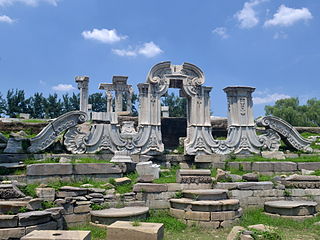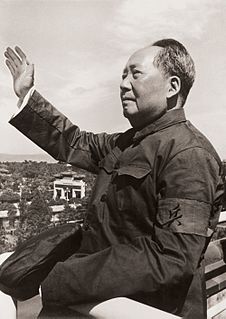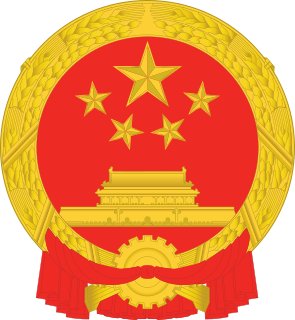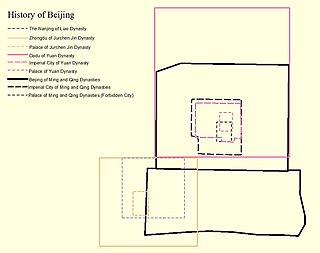 W
WThe 1976 Tangshan earthquake, also known as the Great Tangshan earthquake, was a natural disaster resulting from a magnitude 7.6 earthquake that hit the region around Tangshan, Hebei, People's Republic of China on 28 July 1976, at 3:42 in the morning. The maximum intensity of the earthquake was XI (catastrophe) on the Mercali scale. In minutes, eighty-five percent of the buildings in Tangshan collapsed or were unusable, all services failed, and most of the highway and railway bridges collapsed or were seriously damaged. At least 242,000 people died, making this the third deadliest earthquake in recorded history. The lack of warning and foreshocks, in contrast to the earlier 1975 Haicheng earthquake, was a principal factor in the large number casualties.
 W
WThe Albazinians are one of the few groups of Chinese of Russian descent. There are approximately 250 Albazinians in China who are descendants of about fifty Russian Cossacks from Albazin on the Amur River that were resettled by the Kangxi Emperor in the northeastern periphery of Beijing in 1685. Albazin was a Russian fort on the Amur River, founded by Yerofey Khabarov in 1651. It was stormed by Qing troops in 1685. The majority of its inhabitants agreed to evacuate their families and property to Nerchinsk, whereas several young Cossacks resolved to join the Manchu army and to relocate to Beijing. See Sino-Russian border conflicts.
 W
WThe APEC China 2014 was the 22nd annual gathering of APEC leaders. It was held in Yanqi Lake, Huairou District, Beijing on 10–12, November 2014.
 W
WThe Beijing city fortifications were constructed from the early 1400s to the year 1553. The inner city's wall was 24 kilometres (15 mi) long and 15 metres (49 ft) high, with a thickness of 20 metres (66 ft) at ground level and 12 metres (39 ft) at the top, and had nine gates. The wall stood for nearly 530 years, but in 1965, it was removed to allow for construction of the 2nd Ring Road and Line 2 of the Beijing Subway. Only one part of the original wall still exists, just south of the Beijing railway station in the southeast portion of the city. The Outer city walls had a perimeter of approximately 28 kilometres (17 mi). The entire enclosure of the Inner and Outer cities formed a "凸" shape with a perimeter of nearly 60 kilometres (37 mi).
 W
WThe Beijing Treaty on Audiovisual Performances is a multilateral treaty which regulates copyright for audiovisual performances and expands the performers' rights. It was adopted on 26 June 2012 by the Diplomatic Conference on the Protection of Audiovisual Performances of the World Intellectual Property Organization, in which 156 WIPO member states, six intergovernmental, and six non-governmental organizations participated. Forty-eight countries signed the treaty on 26 June, followed by 19 other countries in 2012 and 2013. The treaty has 37 parties and entered into force on 28 April 2020 following the receipt of the 30th ratification.
 W
WThe Battle of Zhongdu was a battle in 1215 between the Mongols and the Jurchen Jin dynasty, which controlled northern China. The Mongols won and continued their conquest of China.
 W
WThe Boxer Protocol was signed on September 7, 1901, between the Qing Empire of China and the Eight-Nation Alliance that had provided military forces ; after China's defeat in the intervention to put down the Boxer Rebellion. It is often regarded as one of the Unequal Treaties.
 W
WCaishikou Execution Grounds was an important execution ground in Peking during the Qing Dynasty. It was located at the crossroads of Xuanwumen Outer Street and Luomashi Street. The exact location is under debate today. However, contemporary sources and photographs put it across from an apothecary shop named He Nian Tang (鶴年堂藥店).
 W
WThe Beijing Guozijian, located on Guozijian Street in Beijing, China, was China's national university during the Yuan, Ming and Qing dynasties, and the last Guozijian of China. Most of the Beijing Guozijian's buildings were built during the Ming Dynasty and it remains an important heritage site in China. During the Hundred Days' Reform of the Qing Dynasty, the education and administration of education functions of Guozijian was mainly replaced by the Imperial University of Peking, later known as Peking University. The Guozijian was shut down in 1905.
 W
WKhanbaliq or Dadu (元大都) was the winter capital of the Yuan dynasty, the main center of the Mongol Empire founded by Kublai Khan in what is now Beijing, also the capital of China today. It was located at the center of modern Beijing. The Secretariat (中书省) directly administered the Central Region (腹裏) of the Yuan Empire and dictated policies for the other provinces. Kublai and his successors also claimed supremacy over the entire Mongol Empire following the death of Möngke Khan in 1259. Over time the unified empire gradually fragmented into a number of khanates.
 W
WThe Marco Polo Bridge Incident, also known as the Lugou Bridge Incident or the Double-Seven Incident, was a July 1937 battle between China's National Revolutionary Army and the Imperial Japanese Army.
 W
WThe May Fourth Movement was an anti-imperialist, cultural, and political movement which grew out of student protests in Beijing on 4 May 1919.
 W
W"Beijing" is the atonal pinyin romanization of the Mandarin pronunciation of the Chinese characters 北京, the Chinese name of the capital of China.
 W
WNanjing was the name for modern Beijing during the Liao dynasty, when Khitan rulers made the city the southern capital. To distinguish Nanjing, which literally means "Southern Capital" in Chinese, from modern Nanjing in Jiangsu Province and Beijing Damingfu, the Northern Song Dynasty name for modern Daming County in Hebei Province, Chinese historians sometimes refer to Beijing during the Liao dynasty as Liao Nanjing. The Khitan rulers of the Liao acquired the city, then known as Youzhou, in the cession of the Sixteen Prefectures in 938 from the Later Jìn, one of the five shortlived dynasties that ruled northern China following the end of the Tang Dynasty. The city was officially renamed Nanjing, Youdu Fu (南京幽都府). In 1012, the city was renamed Nanjing, Xijin Fu (南京析津府). The city was also colloquially referred to at the time as Yanjing. In 1122, the city was captured by the Jurchen Jin dynasty and was officially renamed Yanjing, ending the use of Nanjing for what is today modern Beijing.
 W
WThe Old Summer Palace, known in Chinese as Yuanming Yuan, and originally called the Imperial Gardens, was a complex of palaces and gardens in present-day Haidian District, Beijing, China. It is 8 kilometres (5.0 mi) northwest of the walls of the former Imperial City section of Beijing. Constructed throughout the 18th and early 19th centuries, the Old Summer Palace was the main imperial residence of Qianlong Emperor of the Qing dynasty and his successors, and where they handled state affairs; the Forbidden City was used for formal ceremonies. Widely perceived as the pinnacle work of Chinese imperial garden and palace design, the Old Summer Palace was known for its extensive collection of gardens, its building architecture and numerous art and historical treasures. It was reputed as the "Garden of Gardens" in its heyday.
 W
WThe Battle of Palikao was fought at the bridge of Palikao by Anglo-French forces against the Qing Empire during the Second Opium War on the morning of 21 September 1860. It allowed Western forces to take the capital Beijing and eventually defeat the Qing Empire.
 W
WPeking Man is a group of fossil specimens of Homo erectus, dated from roughly 750,000 years ago, discovered in 1929–37 during excavations at Zhoukoudian near Beijing, China.
 W
WThe Battle of Beijing, or historically the Relief of Peking, was the battle fought on 14–15 August 1900 in Beijing, in which the Eight-Nation Alliance, led by the British, relieved the siege of the Beijing Legation Quarter during the Boxer Rebellion. From 20 June 1900, Boxers and Imperial Chinese Army troops had besieged foreign diplomats, citizens and soldiers within the legations of Austria-Hungary, Belgium, Britain, France, Italy, Germany, Japan, Netherlands, Russia, Spain and the United States.
 W
WQuelling the People: The Military Suppression of the Beijing Democracy Movement is a history book which investigates the conflict between the Chinese democracy movement in Beijing, China and the communist-ruled Chinese state's People's Liberation Army, culminating in the confrontation between the citizens of Beijing and the People's Liberation Army at Tiananmen Square in June 1989.
 W
WThe Red August, originally meaning August 1966 of the Cultural Revolution, is also used to indicate a series of massacres in Beijing which mainly took place during the period. According to the official statistics in 1980, from August to September in 1966, a total of 1,772 people—including teachers and principals of many schools—were killed in Beijing by Red Guards; in addition, 33,695 homes were ransacked and 85,196 families were forced to leave the city. The killing by the Red Guards also made an impact on several rural districts of Beijing, causing the "Daxing Massacre", for example, during which 325 people were killed from August 27 to September 1 in Daxing District of Beijing. The oldest killed during the Daxing Massacre was 80 years old, while the youngest was only 38 days old; 22 families were wiped out. Scholars have also pointed out that, according to the official statistics in 1985, the actual death toll during the Red August was over 10,000.
 W
WThe Siege of the International Legations occurred in 1900 in Peking, the capital of the Qing Empire, during the Boxer Rebellion. Menaced by the Boxers, an anti-Christian, anti-foreign peasant movement, 900 soldiers, marines, and civilians, largely from Europe, Japan, and the United States, and about 2,800 Chinese Christians took refuge in the Peking Legation Quarter. The Qing government took the side of the Boxers. The foreigners and Chinese Christians in the Legation Quarter survived a 55-day siege by the Qing Army and Boxers. The siege was broken by an international military force which marched from the coast of China, defeated the Qing army, and occupied Peking. The siege was called by the New York Sun "the most exciting episode ever known to civilization."
 W
WThe Tiananmen Incident was a mass gathering and protest that took place on 5 April 1976, at Tiananmen Square in Beijing, China. The incident occurred on the traditional day of mourning, the Qingming Festival, after the Nanjing Incident, and was triggered by the death of Premier Zhou Enlai earlier that year. Some people strongly disapproved of the removal of the displays of mourning, and began gathering in the Square to protest against the central authorities, then largely under the auspices of the Gang of Four, who ordered the Square to be cleared.
 W
WThe Walls and Gates of Peking is a book written by Osvald Sirén, originally published in English with a run of 800 copies by The Bodley Head in London in 1924. It provides historical records of the walls and gates of Beijing and has 109 photos taken by Osvald Siren and 53 architectural drawings of gates made by Chinese artists.
 W
WThe Wanggongchang Explosion, also known as the Great Tianqi Explosion (天啟大爆炸), Wanggongchang Calamity (王恭廠之變) or Beijing Explosive Incident in Late Ming (晚明北京爆炸事件), was a catastrophic explosion that occurred on May 30, 1626, during the late reign of Tianqi Emperor, at the heavily populated Ming China capital Beijing, and reportedly killed around 20,000 people. The epicenter was a major production center of gunpowder, but it is uncertain exactly what triggered the explosion.
 W
WOn the morning of 8 January 1937, the severely mutilated body of Pamela Werner was found near the Fox Tower in Beijing, just outside the city's Legation Quarter. The only child of sinologist and retired British diplomat E. T. C. Werner, she had last been seen by acquaintances just before leaving a skating rink the previous night. No one was ever charged in the case.
 W
WWonderland was an unfinished amusement park project located in Chenzhuang Village (陈庄村), Nankou Town (南口地区), Changping District, China, about 32 kilometres (20 mi) outside of Beijing. Originally proposed by the Thailand-based property developer Reignwood Group, and designed to be the largest amusement park in Asia, construction stopped in 1998 following financial problems with local officials, while a 2008 attempt to start construction again also failed.
 W
WYan was an ancient Chinese state during the Zhou dynasty. Its capital was Ji. During the Warring States period, the court was also moved to another capital at Xiadu at times.
 W
WBattle of Zhangjiawan or Chang-kia-wan was fought by British and French forces against China at the town of Zhangjiawan during the Second Opium War on the morning of 18 September 1860.
 W
WZhongdu was the capital of the Jurchen-led Jin dynasty in medieval China. It was located in the southwestern part of Beijing's Xicheng District. It had a population of nearly one million by the late 12th century, and was the last and largest pre-modern city built on that location.